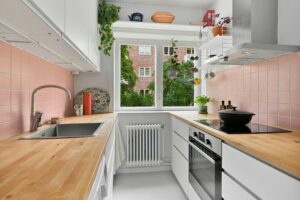Personalized Kitchen Designs: Crafting Your Culinary Haven from Scratch


Every home deserves a kitchen that feels like its heart; personalization is the key to achieving that. Instead of relying on cookie-cutter layouts, homeowners today prefer designs that reflect their lifestyle, cooking habits, and even aesthetic preferences. By tailoring each element to individual needs, you create a workspace and a warm environment where creativity and comfort coexist.
Moreover, a personalized kitchen adds lasting value to a home. When each element, from cabinetry to countertops, mirrors your taste, it transforms daily routines into enjoyable experiences. Whether you’re a casual cook or a culinary enthusiast, your kitchen should tell your story and support your unique way of living.
Defining Your Style and Functionality
When designing your dream kitchen, the first step is defining your style. Some homeowners gravitate toward sleek modern lines, while others find comfort in rustic or farmhouse-inspired spaces. Identifying your preferred aesthetic ensures the design feels cohesive and authentic to your lifestyle.
At the same time, functionality should remain a priority. Even the most beautiful design falls short if it doesn’t serve your daily needs. For example, strategically placing appliances, choosing the right countertop height, and planning efficient storage solutions can significantly affect how smoothly your kitchen operates.
Choosing the Right Layout
The layout is the backbone of your kitchen design and directly impacts how you move around the space. Popular options include the U-shaped, L-shaped, galley, and open-concept layouts. Each provides unique advantages, depending on the size of your kitchen and how you plan to use it.
Equally important, a well-thought-out layout encourages better workflow. Known as the “kitchen work triangle,” the stove, sink, and refrigerator relationship should be efficient and logical. This arrangement saves time and reduces unnecessary movement, making cooking and cleaning more enjoyable.
Custom Cabinetry and Storage Solutions
Cabinetry defines a kitchen’s appearance and functionality. Custom cabinets offer flexibility in size, style, and finish, ensuring that every inch of space is used wisely. Options like pull-out drawers, corner carousels, and vertical dividers allow you to maximize efficiency without sacrificing aesthetics.
In addition, innovative storage solutions can significantly reduce clutter. For instance, built-in spice racks, hidden trash compartments, and under-cabinet lighting enhance practicality and visual appeal. Thinking creatively about storage lets you keep your countertops clear and your kitchen organized.
Selecting Materials and Finishes
The choice of materials sets the tone for your kitchen. Durable countertops like quartz or granite offer longevity and beauty, while backsplashes of tile or glass add a decorative touch. Depending on your budget and lifestyle, flooring materials such as hardwood, ceramic, or vinyl each bring their own benefits.
Beyond durability, finishes play a critical role in achieving harmony. Matte, glossy, or textured finishes can influence how light interacts with the space, creating different moods. By mixing complementary materials, you can strike a balance between functionality and design elegance.
Lighting for Ambiance and Function
Lighting transforms a kitchen from a purely functional space into an inviting atmosphere. Ambient lighting, such as ceiling fixtures, provides general illumination, while task lighting focuses on countertops and cooking zones. Accent lighting, on the other hand, adds drama by highlighting unique design elements.
Furthermore, combining natural and artificial lighting enhances both mood and practicality. Large windows, skylights, or glass doors invite sunlight during the day, while layered artificial lights ensure nighttime visibility. This thoughtful blend improves the overall experience and sets the tone for gatherings.
Integrating Technology
Modern kitchens benefit significantly from the integration of technology. Smart appliances, such as Wi-Fi-enabled ovens or voice-controlled assistants, make cooking more efficient and enjoyable. These tools allow you to control temperature, set timers, and even look up recipes with minimal effort.
Additionally, technology enhances energy efficiency. Induction cooktops, motion-sensor faucets, and energy-saving refrigerators reduce utility bills and contribute to a sustainable lifestyle. Incorporating these features ensures that your kitchen remains practical and future-ready.
Adding Personal Touches
A personalized kitchen should always include details that reflect your individuality. Whether it’s a colorful backsplash, open shelving to display cherished dishware, or a breakfast nook filled with cozy seating, these touches make the space feel uniquely yours. Small choices often have the most significant impact, transforming a standard kitchen into a one-of-a-kind haven.
At the same time, accessories and décor contribute to the overall atmosphere. These elements add warmth and character, from artwork and plants to unique light fixtures and custom hardware. By layering functional design with personal charm, you create a complete kitchen.
Building Your Culinary Haven
Designing a personalized kitchen is more than just a home improvement project; it’s a journey toward creating a space where functionality and personality merge. By prioritizing style, layout, storage, lighting, and technology, you ensure that your kitchen serves as both a workspace and a gathering place.
Ultimately, a well-designed kitchen becomes the true heart of your home. With thoughtful planning and creativity, you can craft a culinary haven that supports your daily routines and enhances your lifestyle for years to come.
